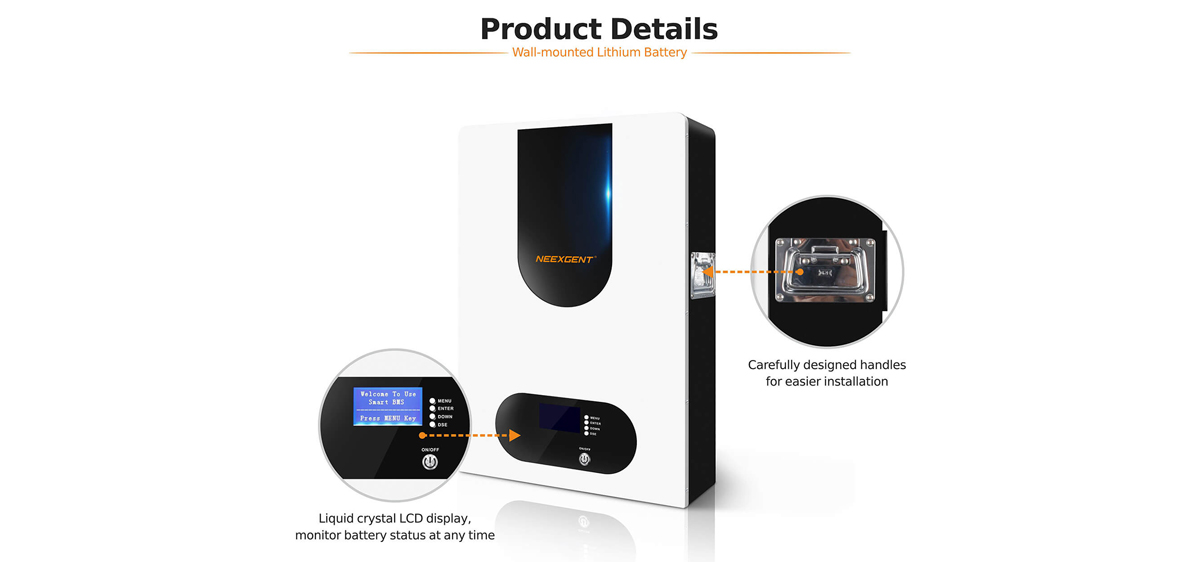In an era where renewable energy is gaining momentum and households are becoming more conscious of their carbon footprint, energy storage solutions have become a crucial element in the quest for sustainable living. Wall-mounted batteries, also known as home energy storage systems, have emerged as a game-changer in this landscape. Offering homeowners a reliable and efficient means of storing electricity generated from renewable sources, these innovative devices are reshaping the way we power our homes. In this article, we will explore the concept of wall-mounted batteries, their benefits, and their potential to revolutionize the energy industry.

48V HOME POWER WALL LIFEPO4 BATTERY
1. What are Wall-Mounted Batteries?
Wall-mounted batteries are compact, self-contained units designed to store electrical energy in homes and buildings. They are typically connected to a renewable energy system, such as solar panels, wind turbines, or grid electricity, allowing homeowners to store excess electricity for later use. These batteries are installed directly on the wall, similar to a fuse box or electrical panel, making them convenient and space-saving solutions for residential energy storage.

2. The Benefits of Wall-Mounted Batteries:
One of the primary advantages of wall-mounted batteries is the ability to achieve energy independence. By storing excess electricity, homeowners can rely less on the traditional power grid, reducing their dependency on fossil fuel-based energy sources. This autonomy not only provides peace of mind during power outages but also contributes to a more sustainable and resilient energy ecosystem.
Wall-mounted batteries enable homeowners to maximize their renewable energy investment. They allow for the efficient utilization of excess electricity generated during peak production periods, which can then be consumed when energy demand is higher or during non-generating periods. This feature helps to offset peak electricity rates, resulting in significant cost savings on utility bills.
The integration of wall-mounted batteries into the energy grid can contribute to enhanced stability and reliability. These devices can help regulate electricity flow by storing excess energy during periods of low demand and releasing it during peak usage times. By reducing strain on the grid, they promote a more balanced and efficient energy distribution system.
- Environmental Sustainability:
The utilization of wall-mounted batteries significantly reduces reliance on non-renewable energy sources, such as coal or natural gas. By storing and consuming clean, renewable energy, homeowners can minimize their carbon footprint and actively contribute to a greener future. Furthermore, the widespread adoption of wall-mounted batteries can facilitate the integration of renewable energy into the grid, accelerating the transition to a low-carbon economy.

3. Technological Advances:
Thanks to advancements in battery technology, wall-mounted batteries have become more efficient, affordable, and durable. Lithium-ion batteries, which are commonly used in these systems, have witnessed significant improvements in energy density and cycle life. Additionally, the integration of smart monitoring and management systems enables homeowners to optimize energy consumption, track performance, and even participate in demand-response programs.

4. The Future of Wall-Mounted Batteries:
As renewable energy continues to gain momentum, the future of wall-mounted batteries appears promising. With ongoing research and development, we can expect further improvements in battery capacity, efficiency, and lifespan. As costs decrease and energy storage capabilities increase, these devices will likely become even more accessible to a wider range of homeowners, further accelerating the clean energy transition.
The widespread adoption of wall-mounted batteries has the potential to transform the energy industry. As more households integrate renewable energy systems into their homes, the demand for energy storage solutions will continue to grow. This increased demand will drive further innovation, leading to advancements in battery technology and cost reduction.
Their residential applications, wall-mounted batteries can also have a significant impact on commercial and industrial sectors. Businesses can benefit from storing excess energy during off-peak hours and using it when demand is high or during power outages. This not only reduces operational costs but also provides a reliable backup power source, ensuring uninterrupted operations.
The integration of wall-mounted batteries into smart grids holds great promise for optimizing energy distribution and management. By leveraging advanced monitoring and control systems, these batteries can participate in demand-response programs, where they respond to fluctuations in electricity supply and demand. This capability enhances grid stability and enables more efficient energy utilization.
Cchallenges still exist in the widespread adoption of wall-mounted batteries. The upfront cost of these systems can be a barrier for some homeowners, although decreasing battery prices and government incentives are making them more affordable. Additionally, the recycling and disposal of batteries should be addressed to ensure minimal environmental impact.
Wall-mounted batteries are revolutionizing the way we store and utilize electricity. They offer numerous benefits, including energy independence, cost savings, grid stabilization, and environmental sustainability. As technology continues to advance and costs decrease, wall-mounted batteries will become increasingly accessible and integral to our energy infrastructure. With their potential to reshape the energy industry and accelerate the clean energy transition, these batteries are paving the way towards a more sustainable and resilient future.









